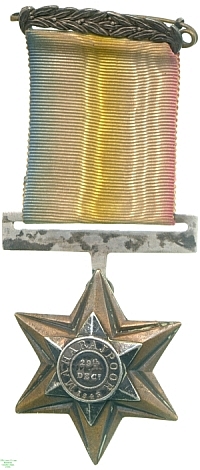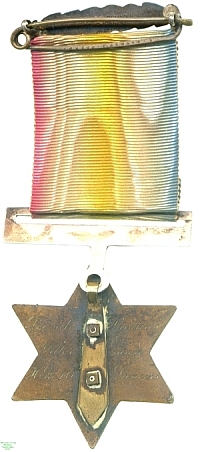
Obverse, inscriptions on a small six-pointed star itself mounted on a larger one

Reverse, a six-pointed star engraved with recipient's name

Obverse, inscriptions on a small six-pointed star itself mounted on a larger one |

Reverse, a six-pointed star engraved with recipient's name |
The Kingdom of Gwalior, whose capital lies south of Agra in the north of modern India, was ruled along with Ujjain by the Maratha Scindia dynasty from 1731, although after the defeat of the Maratha states in the Third Anglo-Maratha War in 1818 it was forced to recognise British suzerainty. Its native rulers however continued to hold local power until the creation of independent India in 1947.
In 1843 however Maharaja Jankojirao II Scindia died, with his appointed heir Jayajirao still an infant of 10 years, and the Maharaja's widow, not Jayajirao's mother, was party to the instalment of a regency under the Prime Minister, Dada Khasgee Wala, that opposed the succession of the British-supported Jayajirao. A contemporary account exists by the later Baron of Aliwal of the subsequent British campaign that ousted Dada Khasgee Wala and emplaced the young Maharajah on his throne; it culminated in a decisive battle at Maharajpur.
For participation in that battle, or another the same day at Punniar, this star was issued by the Honourable East India Company. The main star was common to both awards; the inner star that specifies the battle for which the award was made is held in by nuts on the reverse.
This example was awarded to Private Thomas Waterman of the 16th Lancers. Lester Watson purchased it at some point before 1928.